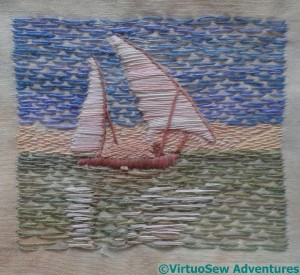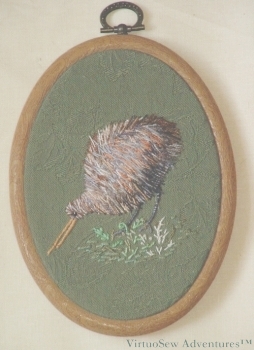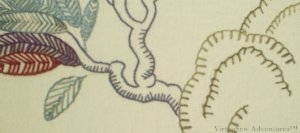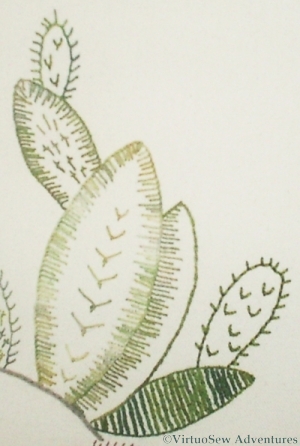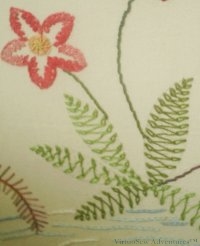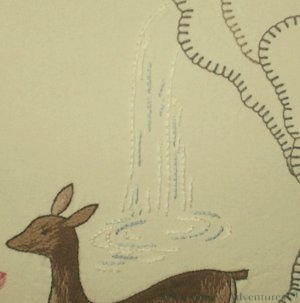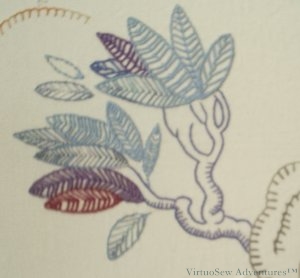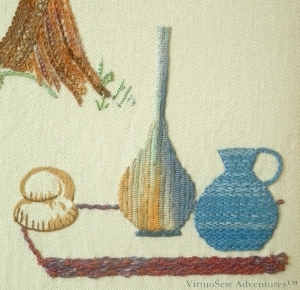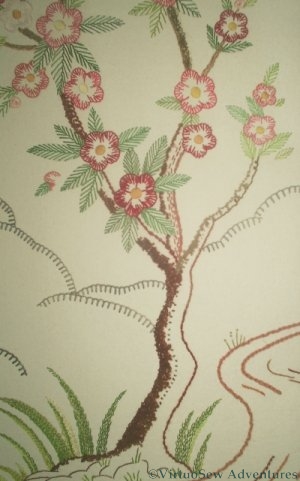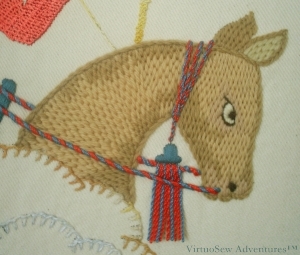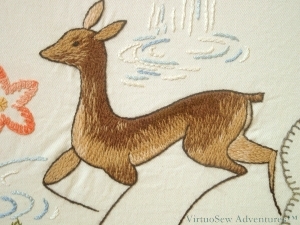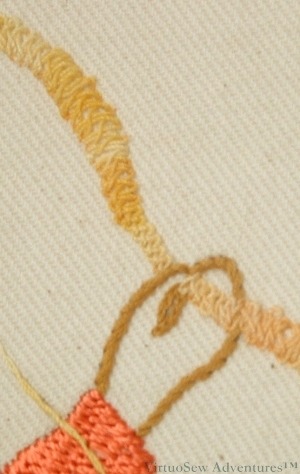Tag: design elements
The Felucca Is Finished
I have finished the first trial of the Felucca design. As I always say of these design fragments, I do not yet know whether they will make it to the final piece.
You can barely see the stitching on the coastline – I used a fine thread and spaced the stitches far apart. For the cargo, I crammed the stitches as close to one another as I could. The sails are worked in Satin Stitches rather than darning, and the spars in Stem Stitches. I’ve decided I am happy with the pinkish tinge on the sails, and the greenish Nile is just as I imagined it would be.
I think it has worked. The reflections of the sails bring the whole piece to life, and I added some small stitches to provide an impression of a reflection of the spars.
Dreams of Amarna – planning the design
After a lot of thought, puzzlement, and general head-scratching, I decided to produce two panels.
The embroidery will be worked on linen, and mounted on board, and in front of each embroidered panel will hang a gauze panel. The gauze will be screen-printed with the most familiar images of Akhenaten and Nefertiti, in a pale “faded” colour. The idea is to reflect the dominance of the historical personages in the work of the archaeologists, who try to interpret what they discover in the ground to tell us more about the historical life of the place itself, and to provide an echo in fabric of Mary Chubb’s own imaginative response to the site.
The linen panels will be made up of several sections. The main sections, in a sandy colour, will be embroidered mainly in monochrome. One panel is to show the map of the site, and the other will provide the links between the work in the office in London and the work in Egypt – sketches of the office building, a steamer, and maybe the Pyramids (visited when they paused in Cairo).
Around these panels smaller panels will be attached, embroidered with representations of some of the finds, with pictures of the excavation, and with any other illustrations I can gather together.
All this came together in a rush, a couple of years ago, when I was helping my cousin to clear out our Great Aunt’s house after her death. You can’t talk about banks and inventories all the time, and the final idea just happened to come together as I began to describe my nagging Project. It deserves the capital letter, don’t you think – ten years, I’ve been thinking about it, maybe more!
Trying Stumpwork
As I’ve already mentioned, almost every embroidery technique I have done has been learnt from a book, or just developed by guesswork based upon something I have read.
In this case, I had been reading about 17th Century stumpwork, and had just returned from a half-business trip, half-holiday in New Zealand. And I had some rather gorgeous overdyed silk threads and wanted to experiment with them!
The body is worked in layers of straight stitches, using several different colours of the overdyed silks. I worked a slip, slightly smaller than the body, on a separate piece of fabric, then applied that piece over some padding, and used more straight stitches to cover the join – very thoroughly!
The legs and the beak are both worked by stitching very closely over a trailing thread of soft cotton. The background fabric is a sturdy cotton damask upholstery fabric, so the close stitchery did no harm. The ground is worked using still more straight stitches, with scroll stitch, coral stitch and fern stitch to create the fragmentary undergrowth.
This was intended just as a piece of fun, but I was happy enough with the outcome to mount it in a flexihoop frame. I’ve bought a couple of books on Stumpwork since I stitched this, but I don’t know that I would have thought of doing the Kiwi this way if I had read the books first.
Stitching the Persian Fantasy – Four
There was so much going on that I consciously reused yarns, colours or stitches across the four panels in order to maintain some semblance of order. In fact as I moved on to each panel I would lay the completed ones side by side on the living room floor and scramble around putting piles of coloured threads on them. It must have looked highly comical, but my parents (I was still living with them when I embroidered these panels) were kind enough not to laugh. Besides, as long as it works…!
I chose to use one of the Caron Collection threads for the basic outlines of the closer landscape, using Up and Down Blanket Stitch, my favourite blanket stitch variation. I’ve done a bit of hunting because it’s one of the more obscure variations and finally found it at the bottom of Sharon B’s Stitch Dictionary page on blanket stitch variations. For the further landscape or clouds (I never did quite work out what they were), I used a different colour range but the same stitch.
The cacti were worked in a variety of stitches, partly based on the lines of the original transfer, but then extrapolated as the stitches and threads suggested themselves. Although I did use several variegated threads in the flowers and the cacti, most of them are pearl-cotton types, and there is a certain unity provided by the use of the same set of threads wherever those forms appear. There are fly stitches, feather stitches, blanket stitches and sword stitches in this small section. I’ve diagrammed Sword Stitch at the end of this post.
The leaves for the largest flowers were worked using chained feather stitch – I had never worked it before and thought it looked fun. I caught down the long connecting stitches with a single strand of cotton, and was delighted to realise that that gave me the effect of a shadowy vein – one of those serendipitous effects that one cannot foresee, but only rejoice in.
The large flowers had centres of Whipped Spiders Web stitch and the outlines were worked in Rosette Chain stitch. The stems were simply a very heavy rayon cord, couched in place. They may well have been the most straightforward element of the entire four panels!
I couldn’t find a diagram of Sword Stitch on the internet anywhere so I spent a bit of time with a vector drawing package and Barbara Snook’s “Embroidery Stitches”, published by Batsford in 1963. I’ve redrawn the diagrams, changing them slightly where I thought the original used a strange order. When working a row, she seems to recommend working from right to left. The only other advice she gives is that the longest arm should point downwards – clearly that is the blade of the sword.
Stitching The Persian Fantasy – Three
I tried very hard to get a photo that does justice to the waterfall here, because it is another example of what I mentioned when I was discussing the gazelle, but I’ve not succeeded very well, I’m afraid.
The interesting point about the waterfall is that it looks like a trivial piece of design – just a few lines – and yet when I came to embroider it, I realised that it would be spoilt if I added “watery” effects with sparkling thread or metallics. I ended up stitching it very simply in stem stitch, using three colours of pearl cotton.
In real life (I wish I were better at photography!) this looks more like a waterfall than a few simple lines have any right to. I’ve looked at this panel over breakfast for ten years now, and I still can’t work out quite how the designer managed to do it!
This tree is a different matter. It doesn’t look much like a real tree, and it isn’t intended to. It is a purely decorative, “tree-ish” element of the design.
I’m coming to realise that the success of these panels rests partly on this balancing act, in which some of the elements look more realistic than others.
Something for us all to try, perhaps!
Stitching the Persian Fantasy – Two
I enjoyed working on the prince’s picnic on panel four. The tall carafe is created using a variegated knitted ribbon (from Stef Francis), and has been used as if appliquéd. The inspiration here was those strange lustre-glazes that show widely differing colours in different lights, and I had great fun choosing particular sections of the yarn to create the effect. The blue jug is much more homespun (sorry – couldn’t resist!), using a Soft Cotton, this time inspired by coiled clay pots – a technique I remembered trying at school, although it was much easier in embroidery! Then there was the loaf of bread, using three shades of a plain matte, round cotton yarn, and the rug (or table – I’m not sure which) bordered with a complex border stitch in a strongly textured yarn.
The bark of the flowering tree on Panel Three was worked using various bouclé and other effect yarns, couched to the surface randomly. The basic design is so stylised that I was careful not to be naturalistic. I used a variety of yarns from a Texere Yarns Inspirations pack and caught them down with a single strand of stranded cotton, in loops and wavy lines. The flowers and leaves were working in plain stranded cottons. The flowering tree was already so dominant in the panel that it really didn’t need much in the way of emphasis from the yarns other than the bark. The tall grasses at the foot of the tree are in stranded cotton too, using feather stitch. I’m not sure that I would do this panel in the same way now, although I think that using satin stitch and long and short stitch, as in the original, might make it look a little serious, rather than decorative and fun.
And I wanted it to be fun.
Stitching the Persian Fantasy – One
I’m glad to say that stitching the Persian Fantasy screen was just as much fun as I hoped it would be! I didn’t follow the instructions in the magazine, not least because it called for “Anchor Flox” , and no-one I could find even knew what that was! I’ve since discovered that it was a very shiny thread, something like a pearl cotton, but made of rayon. I was going to stick with a single type of thread, and conventional stitches, but my mother suggested that I should Be More Adventurous, so I was. I have been grateful to her ever since, as I had enormous fun playing with the threads and stitches.
The four panels show
- the hero out hunting,
- a gazelle in front of a waterfall, perhaps the object of his hunt,
- a flowering tree, and
- the hero again laying out a well-deserved picnic to share with his lady who so far has not appeared.
It is very stylised, very Thirties, but clearly inspired by early Oriental silk paintings. I have a couple of modern ones in a similar style, in fact – inherited from Grandmama, along with the lacquer box!
My knowledge of horses is limited to the direction in which they are going, but I remembered hearing from my horse-mad cousin that horses can get pretty shaggy, and that the lovely glossy look you see on a racehorse is due partly to the horse having had a good haircut. So when I came to do the prince’s steed on the first panel, although I didn’t want him glossy (I wanted the Prince to be glossy), I did want him to look cropped rather than shaggy. So I chose tapestry wool and brick stitch, slightly bent to follow the direction of the coat. I gave him a darkly staring, focused eye, like a warhorse on the Bayeux Tapestry, and matched his reins to the Prince’s clothes, using two colours of Anchor pearl cotton, matching the two colours of Anchor Marlitt rayon thread, twisted together to create cords. The fringe on the headpiece was created using twisted single lengths of pearl cotton, the raw ends plunged and the twisted cords hanging free. I’m still pleased with the horse, and I don’t think I would do him differently now.
The running gazelle on the second panel makes a very good contrast with the Prince’s horse. She was worked using long and short stitch in Paterna crewel wool, with some mixing of colours in the needle, and I quite explicitly aimed for a slightly ragged look around the haunches, although in keeping with the very stylised feel of the whole design, I worked a neat, careful, dark outline of stem stitch. I particularly like the way the designer has made her very clearly a design, not an animal portrait, but at the same time, the single lines for the lower legs are so very reminiscent of the fragile-looking legs of gazelles and other deer.
The Prince’s bow is worked using Braid Stitch, using a mercerised variegated cotton. Archaeological and historical records show that the ancient bows could be very highly decorated while still retaining all their power as a weapon, and I was thinking of descriptions I had read (archaeology is another interest of mine) of bows using horns as the ends, and laminated wood (lamination was invented earlier than you might think) for the main section, all decorated with gold wire inlay. Naturally, all you can see on the embroidered bow is the inlay!

